
In June of 1940, W3XE (later WPTZ and now known as KYW-TV) televised the entire National Convention of the Republican Party. There were a thousand delegates and an equal amount of alternates. The event was held right here in Philadelphia (1940 population was 1,931,334 people) and channel 3, owned by Philco, broadcast a total of 62 hours of coverage. It was the first television station in the history of the world to televise local, non-network reporting of a national political convention. They DID NOT carry the NBC-TV network coverage.
What would eventually become the NBC television network, through its O & O in New York City, 12,000-watt W2XBS, located in midtown Manhattan, operating on Channel One televised thirty and a quarter hours of coverage (reports of 33 hours are incorrect). The station used a series of relays from Philadelphia to New York and on to upper New York State, where the signal may have been sent on to Massachusetts, which would have been a record 325 miles for the transmission of television at that time. The New York City station had its tower on top of the Empire State Building.
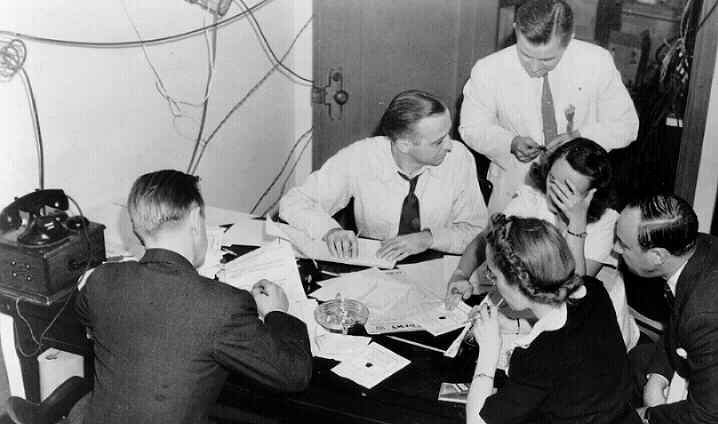
News Reporters at the
GOP Convention in Philadelphia
June 1940
General Electric's station, W2XB in the Schenectady-Albany area, picked up the NYC signal and rebroadcast over their facilities. It was, at that point in time, the longest confirmed live remote in history, 250 miles. Unconfirmed reports state that W1XAE in Springfield, Massachusetts owned by Westinghouse picked up, off the air the GE station and rebroadcast its signal. We have not been able to confirm this but much of our research pointed to the fact that the station may have been dark by that time and therefore could not have broadcast the coverage. It is doubtful at best that a Massachusetts station rebroadcast the NBC-TV feed.
On the day of the balloting (there were six ballots that day), NBC aired 9 hours and 23 minutes of continuous coverage. That became the longest network television program in history to that point. However, W3XE had even more airtime that day which made its feed the longest local television program in history to that point. In fact, it was the longest TV program of ANY type up to that time.
Alfred H. Morton, vice president in charge of NBC Television, headed the NBC-TV coverage. Also involved were NBC's TV program manager, Thomas H. Hutchinson and Burke Crotty, who ran the NBC desk in Philadelphia coordinating transmission back to NYC.
NBC estimated that 40,000 to 50,000 people saw some part of its coverage on TV. The network based this estimate on their belief that 8 to 10 people would make up their audience in front of each receiver located in various points from Springfield to points in Pennsylvania. The Pennsylvania viewers that NBC was talking about were watching the New York station, not W3XE in Philadelphia. An NBC spokesman described the W2XBS coverage area as being located in lower New York State, parts of Massachusetts, a large part of Connecticut, a corner of Pennsylvania and in New Jersey.
According to the July 1940 issue of Radio and Television magazine, the NBC relay was made over a coaxial cable installed by Bell Telephone Labs and ATT (the American Telephone and Telegraph Company). Land lines also connected the Convention Center to the Bourse Building at 5th and Market Streets in Center City Philadelphia (a distance of about four miles) where the terminals were connected to the line to NYC. Every five miles, the phone company had to put in amplifiers "in man holes" to keep the television signal at the same level of clarity until the New York station received the telecast. It was a total of 108 miles.
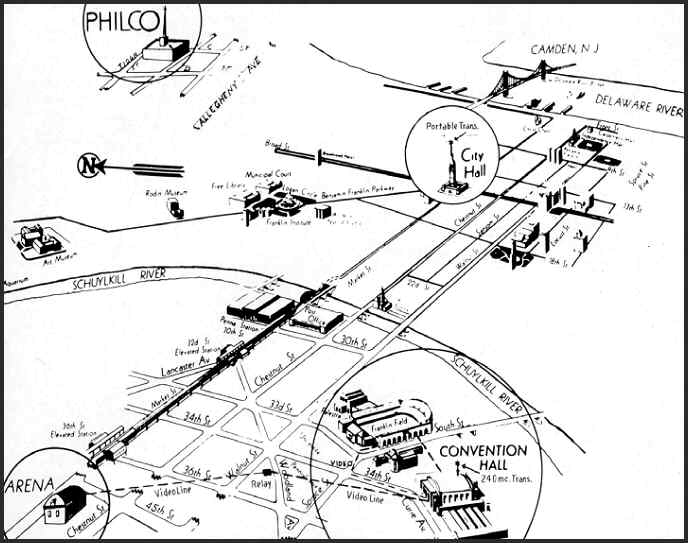
Map of transmission
Convention Hall to Philco Plant
map created in 1941
However, for Philadelphia viewers, the route was totally different. It went from the Convention Center direct to the Philco Plant at C & Tioga Streets in Philadelphia via what was considered a microwave transmission (240 MHz) in that era. The 15,000-watt relay station had the call letters of W3XP. Philco used no land lines in their transmission. W3XE's 10,000-watt signal covered a 25-mile radius from its 230-foot high transmitting tower located in 1940 on the top of the Philco plant at C and Tioga.
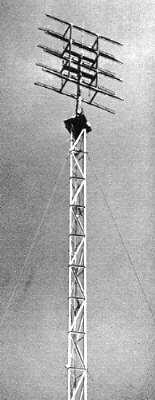
Tower of W3XE
On top of the Philco Plant
C & Tioga Streets in Philadelphia
circa 1940 or early 1941
NBC-TV executives in 1940 said that the GOP convention coverage would constitute the most elaborate television coverage ever given anywhere in the world to a single event. The network sent two complete mobile units to Philadelphia for use in its feeds.
On Friday, June 21, 1940, three days before the start of the convention, a handful of newspaper reporters gathered in the Bourse Building. They saw and heard a demonstration which included Samuel K. Pryor, Jr. of Connecticut, chairman of the Committee on Arrangements for the Convention, tell about the elaborate plans made for the comfort of the delegates. Next Marion Martin, assistant National Republican chairperson, stepped in front of the television camera. Then came the city's leader, Robert Lamberton (the next to the last GOP mayor in the city's history), followed by James H. Malone, Director of Public Safety for the city. He reviewed the work of police assigned to cover the Convention.
Police standing at attention were clearly visible on the television screen as the mayor walked passed. A local reporter, Frank Rosen, said: "Just before the Mayor came in view of the television camera, an airplane could be heard droning overhead. Street noises were clearly audible, especially the honking of horns. Even during daylight hours, the video of the broadcast was quite visible." The size of the receiver screen was seven and a half inches by ten inches. These events, however, were just for the press and not the general public. This was a close circuit feed and never broadcast.
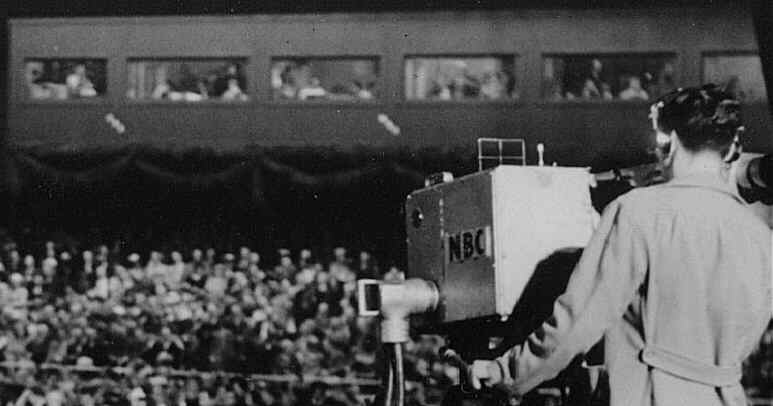
NBC Camera at the
GOP Convention in Philadelphia
June 1940
![]() Initially, we believed that NBC and Philco coverage was the same with local Channel 3 (owned by Philco) carrying almost twice the hours as the network. However, we now are convinced that the NBC and Philco telecasts were not related at all. They were totally separate feeds. We do know that in the July 1, 1940 issue of Broadcasting Magazine, an article said: "Television audiences for the first time in history viewed a national political convention on their receivers when NBC and Philco sent television crews and equipment to the Republican National Convention in Philadelphia."
Initially, we believed that NBC and Philco coverage was the same with local Channel 3 (owned by Philco) carrying almost twice the hours as the network. However, we now are convinced that the NBC and Philco telecasts were not related at all. They were totally separate feeds. We do know that in the July 1, 1940 issue of Broadcasting Magazine, an article said: "Television audiences for the first time in history viewed a national political convention on their receivers when NBC and Philco sent television crews and equipment to the Republican National Convention in Philadelphia."
The publication showed a photo of a TV camera that said "Mutual" with "Philco" directly underneath. That same article said: "Cooperating with MBS (Mutual), Philco also televised the convention via its experimental television station, W3XE. …Philco served the Philadelphia territory, while NBC used coaxial cable facilities to pipe its pickups to New York." This gave us the first indications that they had separate staff and that Philco was working with Mutual and not NBC. It is possible that WIP Radio, the local Mutual radio affiliate, may have played a part in the W3XE coverage. They did make their downtown facilities available to Mutual. How much assistance Mutual gave W3XE is not yet clear.
Even KYW-TV in 1999 had no knowledge that the coverage was separate. The original caption on the first photo (near top of this page) states: "…The program aired in Philadelphia and was carried by coaxial cable to New York. The second photo had this statement: The Channel 3 and network news staff manually tabulates delegate votes during the broadcast of the 1940 Republican National Convention...." Both pictures were from the KYW-TV archives. However, they are reprints and date from after September 10, 1995 as they have the KYW-TV with the CBS logo. (KYW-TV became a CBS O & O on that date).
Neither caption made any mention of NBC at all, but that was probably because the station didn't wish to plug another network. This made it sound like it was a joint project between NBC and Philco. However, this was written half a century after the event. Our investigation has convinced us that they were totally separate feeds. By the way, by the time that W3XE televised the convention in June of 1940, they had already broadcast over 5,000 hours of programming, according to Philco officials. Keep in mind that none of this was commercial TV but telecasts under the Philco experimental license.
It was the week Wendell Willkie won the GOP nomination for President. This televised event (June 24 to June 28, 1940) was the first time a political convention was broadcast on television. It was the station's first remote, according to Joanne Calabria, KYW-TV. There were fewer than a couple hundred TV sets in the Philadelphia market and most of those were owned by Philco and in the homes of employees. At that time, Philco wasn't even offering television receiving sets for sale to the general public.
Television screens were also used to present the convention to "overflow" crowds in the exhibition hall of the Commercial Museum (not Television Commercials) of Philadelphia that was next door to Philly's Convention Hall. Local newspaper reports predicted that two thousand people would view the convention from the museum. Included in this crowd were persons unable to obtain seats in Convention Hall. RCA Victor engineers had installed sixty TV receivers in the Commercial Museum. As of that date, the installation of the sets was the largest single installation ever assembled in one spot in the history of broadcasting. It is unknown whether they were receiving the Philco coverage off the air from Channel 3 or an NBC feed via closed circuit from the hall next door. After our investigation, we believe that they were receiving the NBC material, as RCA (who installed the equipment) owned NBC. We really doubt that RCA would have pushed a competitor's coverage.
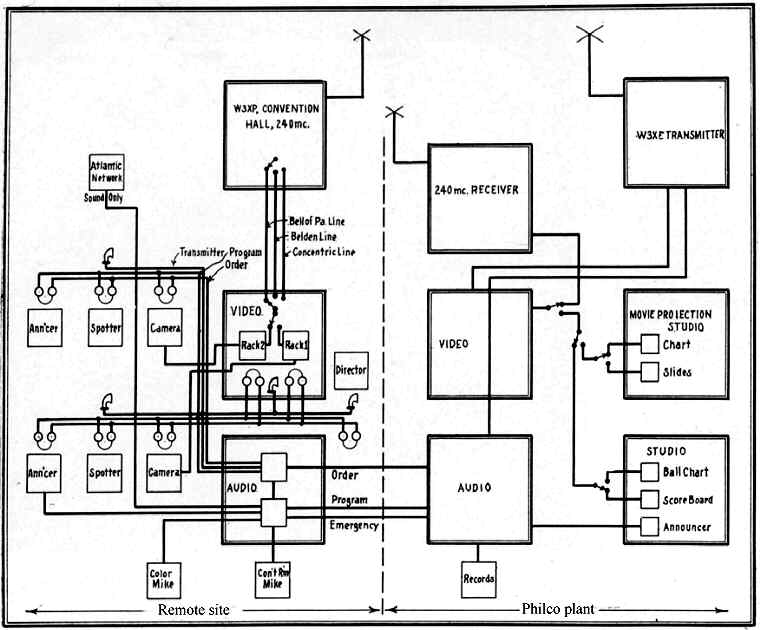
The Setup
Convention Hall & Philco Plant
created in 1941
During this time, Philco (owner of the station at that time) engineers installed an ultra-high frequency relay transmitter with 15,000 watts of power, W3XP, atop Convention Hall (34th & Spruce Streets), in Philadelphia, where the convention was held. It would remain there so that the station could carry sporting events from Franklin Field, a block away.
Convention Hall was less than 10 years old in 1940 and it could accommodate 15,000 people. It had a brand new parking lot and a unique but weird idea in air conditioning (large blocks of ice and huge fans - no joke).
The political party's meeting opened under an "ominous shadow" according to the Philadelphia Record newspaper in a front-page article dated June 25, 1940. "Lizzie," a 42-year-old elephant at the Philadelphia Zoo died. Of course, the elephant is the symbol of the GOP. The Evening Bulletin had reported the death on page 23, the day before.
Front runners for the Republican nomination for President were New York City's District Attorney, Tom Dewey and Ohio U.S. Senator, Robert Taft (son of President Taft). The Tafts (years later) would also purchase Channel 29 in Philadelphia, WIBF-TV renaming it WTAF-TV and making it, their flagship station.
Philadelphia had gained the convention with a bid of $200,000.00. FDR had won Philadelphia, vote wise, in 1936, but the Philadelphia GOP political machine was still in charge in City Hall. The mayor, Robert E. Lamberton (there's a school in the Overbrook Park section of Philadelphia named after him) was a Republican and spoke to the convention welcoming delegates to the city.
He said: "We hope that all of the time you are here, you will feel that you are among friends. We really want to be your friends. Philadelphia is known as the city of Brotherly Love, and from an experience of fifty years, I can attest that the people of Philadelphia are friendly people. We have among our citizens, persons of every race and every creed, but we live in a spirit of peaceful tolerance. No matter what our ancestry, we are Americans first, last, and all the time. From a political viewpoint, you will be among friends. Philadelphia has a Republican mayor and Pennsylvania has a Republican governor. This city has not elected a Democratic mayor within my memory and Pennsylvania in that time has elected a Democratic governor but once. You have returned to the city where the first national convention of the Republican party was held in 1856. …May God give you strength and wisdom...."
An aspiring lawyer from Grand Rapids, Michigan was there shouting with many others, "We Want Willkie." His name was Gerald Ford.
News reports of the day said that convention-goers showed great interest in being televised, as well as watching activities on television receivers which were installed in the Convention Hall itself, the Union League Club and the Commercial Museum.
Philadelphia remains and will forever be the "birthplace" of the televised political convention. It happened first in Philadelphia.
![]()
From the official archives of the Broadcast Pioneers of Philadelphia
Photos courtesy of Norm Gagnon and the GGN Website
Compiled, researched and written by Broadcast Pioneers member Gerry Wilkinson
© 2001, 2005, Broadcast Pioneers of Philadelphia
All Rights Reserved
The e-mail address of the Broadcast Pioneers of Philadelphia is pioneers@broadcastpioneers.com